WHAT'S NEW:
Eruption Confirmed!
New lava (rumbleometer stuck in flow) SE rift zone
(posted 9/1/98)
BACKGROUND:
Technology (ROV, ships, etc.)
Other 1998 Axial cruise reports
EXPEDITION:
Science Objectives
Calendar
Today's Science News
Participant Perspective
Teacher Logbook
EDUCATION:
Curriculum
Teacher Observations
Questions/Answers from sea
MULTIMEDIA:
(video clips, animations, sounds)
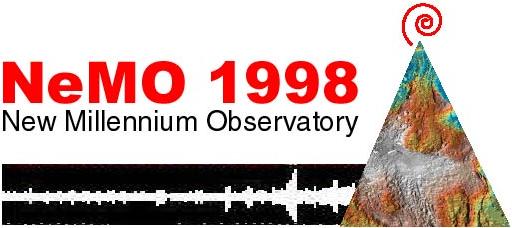
Logbook
September 10, 1998
September 10, 1998
Contents:
Science Report
Daily Science Report - Sep 10
ship's location = 45 56.7N/129 59.1W
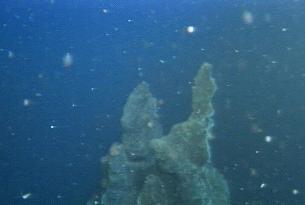
ROPOS is back on Axial's upper south rift zone this morning (where we now know it erupted in January) for dive 473. The main goal of the dive is fluid sampling from the vents that were located on earlier dives (with names like Oxide, Milky, Easy, The Pit, Supersnow, Marker 33, Cloudy, Marker 108, Circ, and Castle (photo at right)). This is the first dive we've made to the rift zone with the fluid sampler, which is now working well. The slurp sampler (see below perspective for photo of slurp sampler) is also on board for biological sampling. The next dive will be devoted to geologic mapping of the extent of the new lava flow.
A little ROPOS trivia that highlights the payload capability of this ROV: During our dives at Axial, ROPOS has been carrying about 250 pounds of science equipment (including all our samplers and sonars and cameras). Impressive, huh? We scientists are always thinking of new gadgets to take down to the seafloor, so it helps to have a hefty vehicle like ROPOS.
 A few dives ago, on dive 469 while ROPOS was at a vent named
Mushroom in the
ASHES vent field, we saw distinct bubbles rising up from the chimney.
(see photo at left) The
bubbles
formed and grew on the lip of the chimney and periodically released and floated
upward
every few seconds. This is quite remarkable considering the tremendous
pressure,
which is about 2200 pounds per square inch at this water depth (1540 meters).
This
was surprising since none of us has ever seen this before at this depth. We
still don't
know what was forming the bubbles, but we should be able to tell once our
samples
are analyzed. Our view at this point is that it is probably not steam (from
boiling of
the hot vent fluid), because the vent fluid at Mushroom is well below the
boiling point
at this depth (100 degrees C vs. 348 degrees C), and because steam bubbles would
quickly condense and collapse as they cooled, whereas the bubbles we saw rose up
at
least several meters above the vent. The other possibility is that it is a gas
being released from the vent fluid, like methane, hydrogen, or CO2 (or some
combination). In fact, we know that the sample taken here did have a remarkable
amount of gas in it. The intriguing thing is that it would take a lot of gas
production to make so much that it all would not stay dissolved in seawater.
Where is it coming from? And why does it show up here and not elsewhere? And
why is this the first time we have seen this here?
A few dives ago, on dive 469 while ROPOS was at a vent named
Mushroom in the
ASHES vent field, we saw distinct bubbles rising up from the chimney.
(see photo at left) The
bubbles
formed and grew on the lip of the chimney and periodically released and floated
upward
every few seconds. This is quite remarkable considering the tremendous
pressure,
which is about 2200 pounds per square inch at this water depth (1540 meters).
This
was surprising since none of us has ever seen this before at this depth. We
still don't
know what was forming the bubbles, but we should be able to tell once our
samples
are analyzed. Our view at this point is that it is probably not steam (from
boiling of
the hot vent fluid), because the vent fluid at Mushroom is well below the
boiling point
at this depth (100 degrees C vs. 348 degrees C), and because steam bubbles would
quickly condense and collapse as they cooled, whereas the bubbles we saw rose up
at
least several meters above the vent. The other possibility is that it is a gas
being released from the vent fluid, like methane, hydrogen, or CO2 (or some
combination). In fact, we know that the sample taken here did have a remarkable
amount of gas in it. The intriguing thing is that it would take a lot of gas
production to make so much that it all would not stay dissolved in seawater.
Where is it coming from? And why does it show up here and not elsewhere? And
why is this the first time we have seen this here?
Listing of all Science News postings
Life at Sea: Participant Perspective
Craig Moyer
Western Washington University
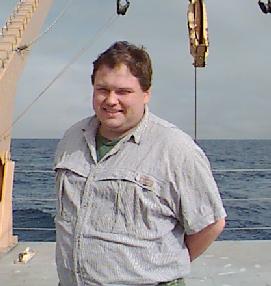
Good Day and welcome to NeMO98!
My name is Craig Moyer. I am an assistant professor at Western Washington University, where I am a member of the biology department. My specialty is molecular microbial ecology of hydrothermal vent habitats. You may wonder what exactly is it that a molecular microbial ecologist does (I know I do . . . often). Well, because many prokaryotes (bacteria and archaea) look alike, I use bio-molecules like ribosomal DNA as name tags to help identify the different kinds of microbes that like to live at hydrothermal vents like the ones here at Axial Volcano. These bio-molecules not only work just like the bar codes that get scanned at the grocery store, but they also store information regarding who is most related to whom. Therefore, my job is basically that of a microbe census-taker and genealogist. In addition, I try to understand how the structure of different microbial communities relates to the different types of chemistry we see at the vents. If that weren't enough, I also attempt to keep track of how these microbial communities change across space (across a single vent, from one end of the vent site to the other, or even from one geographical region to another) and over time (from days to months to years).
Hydrothermal vents are a great place to study the structure and diversity of microbes because many scientists now think that these habitats are where life began almost 4 billion years ago. This means that studying vent microbes is like looking at organisms that have been around for a long time and therefore have been very successful; like studying the Coelacanth if you are interested in fish. Since hydrothermal vents are considered extreme environments, this tends to keep the overall numbers of different types of microbes lower in any single habitat or location than what you would find someplace more mild like forest soil, which has on the order of 10,000 to 100,000 different kinds of microbes per gram! This makes my job a little easier.
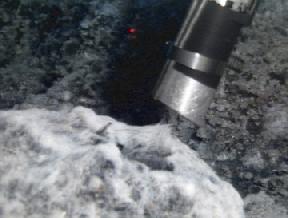 In order to sample the microbial communities, myself and grad student Karen
Pelletreau employ a couple of different approaches. First, we use an underwater
device attached to ROPOS called the
"slurp-gun" (photo right) to vacuum
up microbial mats and capture them in sample jars. Second, we use
"bacteria
traps" (photo below left) which we leave in place for a set amount of time,
allowing the colonization of microbes as the vent effluent passes through a
cylinder covered with a fine mesh with glass wool inside. The bacteria are what
we call substrate-limited, so we give them a place (in this case glass wool made
of inert silica as a substrate) to attach as the hot vent water passes through.
The mesh is to keep the bigger animals like
palm worms and scale worms from
eating all of our samples.
In order to sample the microbial communities, myself and grad student Karen
Pelletreau employ a couple of different approaches. First, we use an underwater
device attached to ROPOS called the
"slurp-gun" (photo right) to vacuum
up microbial mats and capture them in sample jars. Second, we use
"bacteria
traps" (photo below left) which we leave in place for a set amount of time,
allowing the colonization of microbes as the vent effluent passes through a
cylinder covered with a fine mesh with glass wool inside. The bacteria are what
we call substrate-limited, so we give them a place (in this case glass wool made
of inert silica as a substrate) to attach as the hot vent water passes through.
The mesh is to keep the bigger animals like
palm worms and scale worms from
eating all of our samples.
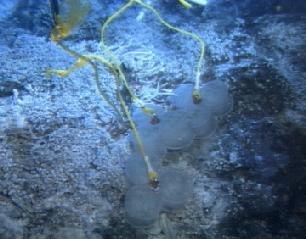 Basically, we provide the microbes with a refuge and
happy place to grow. Upon recovery of these samples, we then preserve them in
liquid nitrogen, for example, for later molecular biological analysis.
Basically, we provide the microbes with a refuge and
happy place to grow. Upon recovery of these samples, we then preserve them in
liquid nitrogen, for example, for later molecular biological analysis.
In addition to studying microbial communities, I am also interested in "culturing" as we microbiologists call it, the more significant members from within the community. This means trying to get the individual types of microbes which are the "major players" to grow in the laboratory. This isn't always an easy task, as many if not most microbes have been found to be unculturable. That doesn't stop us from trying new ways to make them happy. Together with my colleague David Emerson at the American Type Culture Collection, we discovered a novel way to "culture" a new kind of iron-oxidizing bacteria that is able to live completely off the energy from the oxidation of iron (similar to the formation of rust) without requiring a lot of acid around to do it. We have found that this type of bacteria is a major component in many hydrothermal vent systems, and hope to find it here at Axial Volcano as well.
I've been studying the diversity and structure of microbial communities for nearly 8 years now with much of my work happening at places like Loihi, an undersea volcano in Hawaii, or the Guaymas Basin in Mexico. I have been a part of many dive programs with over 75 dives using submersibles and tethered-vehicles, and during this time I have not seen such an amazingly productive tool as ROPOS. It is truly an undersea platform for the future. As I'm sure you an tell from looking at the series of homepages from the NeMO 98 expedition to Axial Volcano, there are many scientists out here with many different projects and interests, and ROPOS has come through like a champ allowing us all to have a wonderful window into the hydrothermal world below. Kudos to the ROPOS team and the captain and crew of the NOAA ship Ron Brown!
Listing of all Perspectives postings
Teacher At Sea Logbook
September 10
Although ROPOS has been busy all day, I had the opportunity to interview one of our scientists on board. What follows is the result of that interview.
Conversation with a Scientist
Lee Evans is a chemist employed at Hatfield Marine Science Center for the Vents Program. His goal for this and other voyages like it is to "suck gas out of volcanic juice." Not just any gas or all gases, but those particular gases that do or may illuminate our understanding of the dynamics of mid-ocean ridges in general and Axial Seamount in particular.
Evans is particularly interested in helium. Helium is a very lightweight gas that exists in two basic forms, or isotopes. Helium-3 contains two protons and one neutron. Helium-4 contains two protons and two neutrons. Evans wants to know the ration of He-3 to He-4 in vent fluids. He wants to know how this ratio and how the total concentration of helium varies geographically from vent to vent, and temporally at any given vent.
Helium is not a particularly common element on Earth, Atoms of helium in the air migrate to the upper atmosphere and away from the ocean. So why is there helium in seawater? The answer to that question lies in what we already know. Helium is more concentrated in vent fluids than in the open sea. The vents are supplying helium to the ocean. Generally speaking the hotter vents are richer in helium because they are in closer contact with the degassing magma that is releasing helium and other gases in response to the lowered pressures near the Earth's surface.
How does helium get into the magma? Scientists believe that the interior temperature of the Earth is maintained by the decay of naturally radioactive elements like uranium. This decay, in addition to producing heat, produces atomic fragments. Sometimes, as in the decay series that leads from uranium to thorium, a portion of the decay fragments are helium atoms. Produced in the heart of the Earth, helium atoms begin a long migration that will take them through the ocean, into the atmosphere, and finally into space. Evans traps a few of them and counts them as they leave the crust and enter the ocean.
How is helium captured? Evans uses gas-tight bottles to collect his samples.
These very expensive titanium collection devices are manufactured to maintain
extreme pressure and temperature gradients. The bottles can be evacuated and
lowered into an environment with an ambient pressure of 200-300 atmospheres and
temperatures of more than 300 degrees Celsius,and no water leaks into the
bottle. Once the bottle is filled with vent fluids under high pressure, the
same system prevents the gases Evans wants to collect from leaking out of the
bottle as it is returned to the one atmosphere pressure and 10 degree Celsius at
the surface.
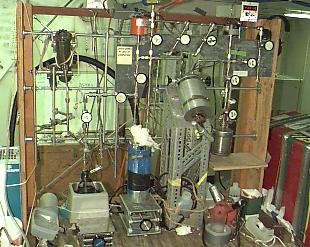
How the helium and other gases are separated and analyzed is a long story, but a picture of the device used to begin the process in included here. (photo right) Ultimately the isotopic ratios will be determined in laboratories on shore. The gas extracted by this equipment is sealed in glass tubes for transport to the labs.
There are some interesting ancillary benefits that derive from our knowledge of helium in vent waters. Since concentration of helium, and presumably He-3 to He-4 ratios, vary from vent to vent, helium becomes a very good tracer in the deep ocean. By tracing the movement of water masses bearing the helium signature it may be possible to learn the direction of some deep ocean circulation. While not all deep waters carry a recognizable source-specific helium signature, those that do allow a reality check for computer generated models of oceanic circulation. At the very least this allows us a clearer understanding of the processes that may be driving global climate cycles. It may seem like a big jump from counting helium atoms to understanding global climate or the structure of the Earth's interior, but that is what brings scientists like Evans to bounce around on the surface of the sea while high tech ships and high tech systems go about the business of collecting water samples leaking from some of the newest crust on Earth. Does Evans enjoy his work? He claims it pays the bills, but if you watch him go about his work you know it means more to him than he is letting on. If you would like to know more about what scientists have discovered regarding vent gases, try visiting the Vents Program's Helium Isotope Laboratory web page.
Logbook of all Teacher At Sea postings
Question/Answer of the Day
Send Your Question to NeMO
(oar.pmel.vents.webmaster@noaa.gov)
Back to Calendar